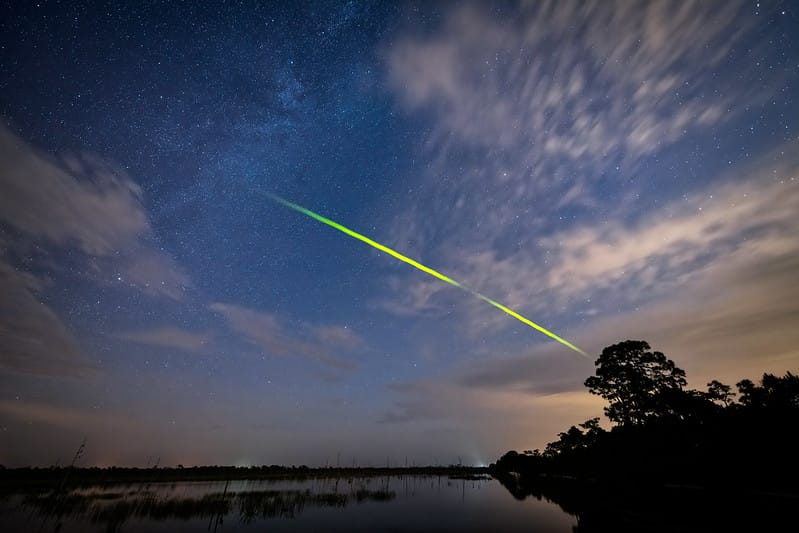Wondering where and how to observe the Eta Aquarid meteor shower so you don’t miss out? Here’s what’s to know, with tips on watching the meteor showers and getting the best views…

If you’ve ever looked up at the night sky and seen a streak of light racing across the sky, you’ve seen a meteor.
The meteor shower to watch…
Eta Aquarids is happening now
The Eta Aquarids is active right now until Monday 27th May 2024. The best viewing for the Eta Aquarids is when the phenomenon peaks on Sunday 5th May 2024. With the crescent waning Moon, 14% full, heading towards a New Moon, you’ll have a dark night for best viewing.
Eta Aquarids is also spelt Eta Aquariid.
Courtesy of the American Meteor Society (Source): Radiant: 22:30 -1° – ZHR: 50 – Velocity: 40.7 miles/sec (swift – 65.5km/sec)
What is eta Aquarids?
You see meteor showers when the Earth passes through debris left behind by a comet or asteroid. The Eta Aquarids comes into view when Earth is passing through the debris left by Halley’s Comet.
As these debris particles enter the Earth’s atmosphere, they burn and create the bright streaks of light known to us as meteors.
Meteor showers get named them after the constellation from where they appear to originate. For example, the Perseid meteor shower emerges from the constellation of Perseus, Leonids from the constellation of Leo, and Geminids from the constellation of Gemini.
The meteor shower of Eta Aquarids is no different. It radiates from the star Eta Aquari in the constelation of Aquarius.
This gives you an idea of where to look. You don’t look directly at Eta Aquari, but it helps to know from where to expect the meteors to radiate from to know the vicinity of where to look.
When and Where to Watch Eta Aquarids in 2024

It’s best if you’re down under.
Southern Hemisphere enthusiasts will get the best view of Eta Aquarids as the shower’s visibility will be more prominent in this part of the world.
Best Time Southern Hemisphere
In the Southern Hemisphere, the peak of this meteor shower is expected to occur on the night of Sunday May 5th through the morning of May 6th, 2024.
Observers in the southern regions can expect to see up to 40 meteors per hour, weather and lighting conditions permitting. It’s advised to look towards the eastern sky after midnight, when Aquarius rises above the horizon, maximizing the number of meteors visible.
Ideal viewing conditions can be found in rural areas far from the light pollution of urban centers. Places like the Australian Outback, the Pampas of Argentina, the Karoo in South Africa or other Southern Hemisphere dark skies offer locations that will enhance the visibility of the meteors.
Best time and place Northern Hemisphere
For those in the Northern Hemisphere, the Eta Aquarids present a more modest show, with an expected peak on the same nights of May 5th to 6th, 2024.
The best viewing spots will be in locations away from city lights, with clear, dark skies. While the radiant point of the shower is lower on the horizon for observers in the north, making for fewer meteors, it’s still possible to catch a good show, particularly just before dawn.
National parks or other areas far from urban light pollution in southern parts of the United States, or similar latitudes around the world, offer the best chance to see these swift meteors streaking through the sky. In these locations, viewers might expect to see up to 10-20 meteors per hour under optimal conditions.
meteor showers during the year
Here are some popular meteor showers and the general dates of when they occur:
| Meteor Shower | Peak Date* | Approx. No. Meteors per Hour |
|---|---|---|
| Perseids | August 12-13 | 60-100 |
| Geminids | December 13-14 | 120 |
| Leonids | November 17-18 | 10-15 |
| Eta Aquariids | May 5–6 | Up to 50 |
| Draconids | Oct 8–9 | Up to 10 |
| Orionids | Oct 21–22 | Up to 20 |
| Quadrantids | Jan 3–4 | Up to 110 |
| Lyrids | Apr 21-22 | Up to 18 |
Like Messier Objects, meteor showers will build your appreciation of astronomy.
How to Prepare for Meteor Shower Watching
Watching meteor showers can be an awe-inspiring experience. It’s important to be well-prepared to make the most of it. Here are some tips on how to prepare for meteor shower watching.
What to Wear
When it comes to meteor shower watching, comfort is key. Dressing in layers will mean you can easily adjust your clothing to changing temperatures.
Comfy shoes are a must. You may be standing or walking for extended periods. Also, consider a hat and gloves to keep your head and hands warm.
What to Bring
To make your meteor shower watching experience as enjoyable as possible, bring along some essential items. Here are a few things you might consider:
- Blankets or chairs to sit or lay down on
- Snacks and water to keep you hydrated and nourished
- Insect repellent to keep pesky bugs at bay
- Flashlights with red filters to preserve your night vision
- Binoculars or a telescope to get a closer look at the objects you see
It’s also a good idea to bring a star chart or a smartphone app that can help you identify stars and constellations. This can add to the fun and excitement of your meteor shower watching experience.
Tips for Watching Meteor Showers
The best place to watch meteor showers is away from city lights – naturally. Light pollution can make it difficult to see meteors, so try to find a dark location. Your backyard or a nearby park could be a good option if it’s not too close to streetlights or other sources of light pollution.
The best time to watch meteor showers is when the sky is darkest. This is often between midnight and pre-dawn. However, the darkest nights are around the new Moon phase — see my article on the best time to stargaze.
Of course, meteor showers are not a celestial phenomenon seen during the day.
Check the weather forecast to make sure that the sky will be clear on the night you plan to watch the meteor shower.
There are apps for backyard astronomers and websites where you can check for the best nights to see particular meteor showers from your location. One site that I find useful is timeanddate. It has a meteor shower calendar and it tells you when each peaks in your location.
If you have the opportunity, you can also go to a dark sky site, which is a location that is specifically designated for stargazing. These sites are usually located far away from cities and have little to no light pollution. You can find dark sky sites near you by checking online or asking local astronomy clubs.
If you want to catch a meteor shower, there are a few things you can do to increase your chances of seeing as many meteors as possible. Here are some tips:
How to Increase Your Chances of Seeing a Meteor
- Find a dark location: The darker your viewing location, the more meteors you’ll see. Try to find a spot that is far away from city lights, and avoid places with tall buildings or trees that may obstruct your view of the sky.
- Check the weather: You don’t want to be outside during a meteor shower if it’s cloudy or raining. Check the weather forecast before you head out, and plan accordingly.
- Be patient: It can take up to 30 minutes for your eyes to adjust to the darkness. Once you’re settled in your viewing spot, give yourself some time to adjust before you start looking for meteors.
- Look up: Meteors can appear anywhere in the sky, so don’t focus on one particular area. Keep your eyes moving and scan the entire sky.
How to Photograph Meteor Showers
If you want to capture images of the meteor shower, here are some tips to get you started:
- Use a tripod: To avoid blurry images, use a sturdy tripod to keep your camera steady.
- Use a wide-angle lens: A wide-angle lens will allow you to capture more of the sky and increase your chances of capturing a meteor.
- Use a high ISO: A high ISO will make your camera more sensitive to light, which is important when photographing meteors in the dark.
- Experiment with different shutter speeds: Start with a shutter speed of 30 seconds and adjust as needed. You may need to increase or decrease the shutter speed depending on how bright the meteors are.
- Be patient: Capturing a great image of a meteor takes time and patience. Keep shooting and experiment with different settings until you get the shot you want.
With these tips, you’ll be well on your way to enjoying a spectacular meteor shower. Just remember to be patient, stay alert, and enjoy the show!
How to make it a satisfying experience — Checklist
- Find a dark location away from city lights to minimize light pollution.
- Check the weather forecast and choose a clear night for viewing.
- Bring a comfortable chair or blanket to lie on and dress warmly.
- Allow your eyes to adjust to the darkness for at least 20 minutes.
- Use a red flashlight or cover your flashlight with red cellophane to preserve night vision.
- Look up towards the darkest part of the sky, away from the moon if possible.
- Be patient and keep watching for at least an hour to allow your eyes to adjust and for meteors to appear.
- Try to identify the constellations where the meteor shower is originating from.
- Consider using binoculars or a telescope to observe brighter meteors or other celestial objects.
- Enjoy the experience and appreciate the beauty of the night sky!
- Bring snacks and drinks to keep you energized and hydrated during your observation.
- Use a star chart or astronomy app to help you identify twinkling stars and constellations.
- Plan your observation during peak meteor activity for the specific shower you want to observe.
- Avoid using your phone or other devices with bright screens that can interfere with your night vision.
- Consider setting up a camera or time-lapse to capture the meteor shower.
- If possible, observe with a group of friends or fellow astronomy enthusiasts for a more enjoyable experience.
- Research and learn about the specific meteor shower you plan to observe, including its history and interesting facts.
- Be aware of any local laws or regulations regarding stargazing and outdoor activities.
- Consider joining an astronomy club or organization to learn more about observing meteor showers and other celestial events.
- Have fun and enjoy the beauty of the night sky!

